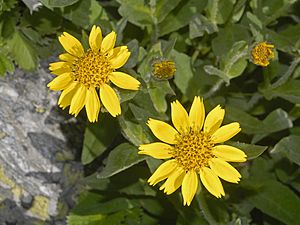Nevada arnica facts for kids
Quick facts for kids Arnica nevadensis |
|
|---|---|
 |
|
| Giardino Botanico Alpino Chanousia in the Italian Alps |
|
| Scientific classification | |
| Genus: |
Arnica
|
| Species: |
nevadensis
|
| Synonyms | |
|
Arnica tomentella Greene |
|
Arnica nevadensis is a special kind of arnica plant found in North America. People often call it Nevada arnica or Sierra arnica. It belongs to the sunflower family, just like sunflowers and daisies! You can find this plant growing in the cool, pine forests of the western United States. It's mostly seen in the Cascades and Sierra Nevada mountains, across states like Washington, Oregon, California, and Nevada.
Discovering Nevada Arnica
Arnica nevadensis is a perennial herb. This means it's a plant that lives for more than two years. It grows one or more stems that can reach about 30 centimeters (about 1 foot) tall. These stems are often a bit hairy and sticky because they have tiny glands.
What Does Nevada Arnica Look Like?
The plant usually has two or three pairs of leaves. These leaves are mostly found on the lower half of the stem. Each leaf is oval-shaped, and the ones closest to the bottom can be up to 8 centimeters (about 3 inches) long.
Its Flowers and Seeds
The plant's inflorescence (which is how its flowers are arranged) holds one to three flower heads. These look a lot like small daisies. Each flower head is surrounded by special leaves called phyllaries. These phyllaries are also covered in tiny, sticky glands.
The center of each flower head has many small, yellow disc florets. Around the edge, there's a fringe of bright yellow ray florets. After the flowers bloom, the plant produces a fruit called an achene. This achene has a fluffy, white or cream-colored pappus attached to it, which helps the seeds float away in the wind.

